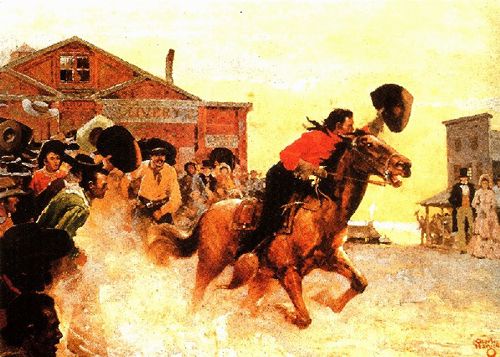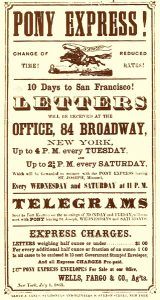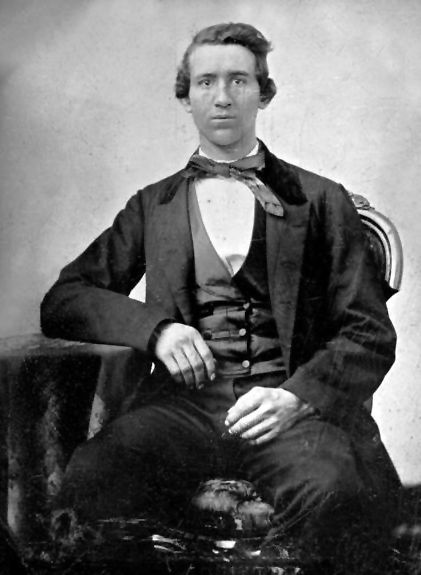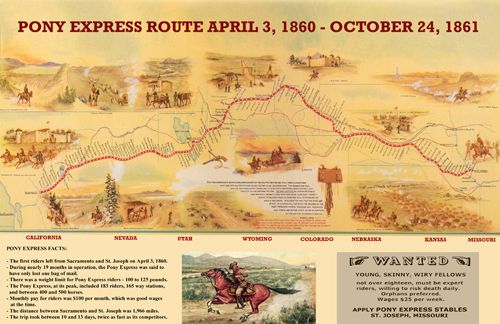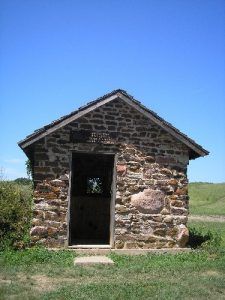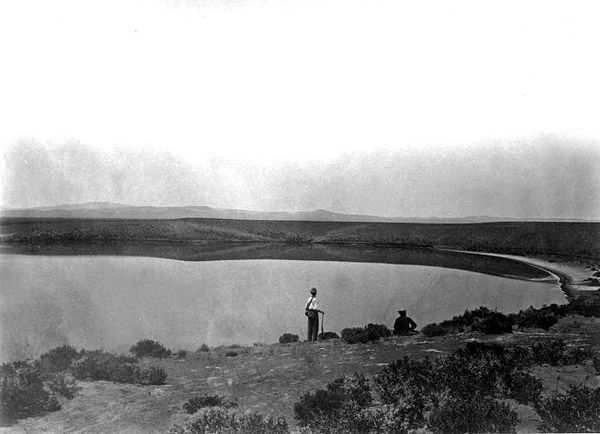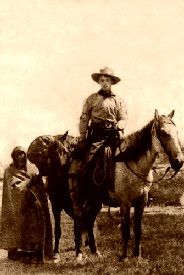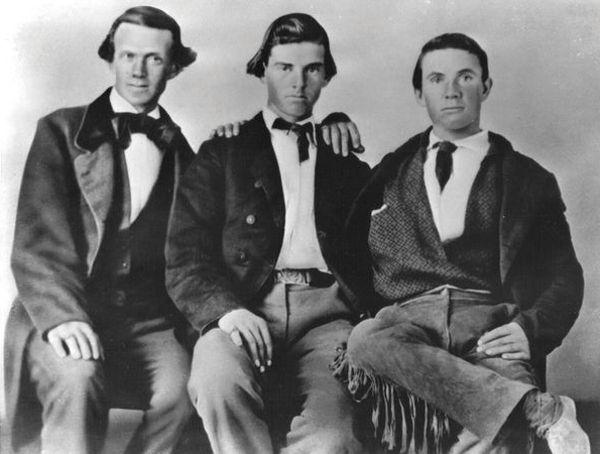Riders of the Pony Express – Legends of America (original) (raw)
By Glenn D. Bradley in 1913
Pony Express by the Bureau of Land Management.
– Bart Riles, the pony rider, died this morning from wounds received at Cold Springs, May 16. – The men at Dry Creek Station have all been killed, and it is thought those at Robert’s Creek have met with the same fate. – Six Pike’s Peakers found the body of the station keeper horribly mutilated, the station burned, and all the stock missing from Simpson’s. – Eight horses were stolen from Smith’s Creek on last Monday, supposedly by road agents.
The above are random extracts from frontier newspapers, printed while the Pony Express ran. The Express could never have existed on its high plane of efficiency without an abundance of coolheaded, hardened men, men who knew not fear and who were expert – though sometimes in vain – in all the wonderful arts of self-preservation practiced on the old frontier. It is needless to assert that these employees could have performed even the simplest of their duties without stirring and almost incredible adventures.
The faithful relation of even a considerable number of the thrilling experiences to which the “Pony” men were subjected would discount fiction. While history can pay the tribute of preserving some anecdotes and their collective achievements, it must be forever silent as to many of their personal acts of heroism.
First Ride of the Pony Express
While lasting praise is due to the faithful station men who, in their isolation, so often bore the murderous attacks of Indians and bandits, it is, perhaps, to the riders that the seeker of romance is most likely to turn. The riders’ skill and fortitude made the operation of the line possible. Both riders and hostlers shared the same privations, often being reduced to the necessity of eating wolf meat and drinking foul or brackish water.
While each rider was supposed to average 75 miles a trip, riding from three to seven horses, accidents were likely to occur, and it was not uncommon for a man to lose his way. Such delays meant serious trouble in keeping the schedule, keyed up, as it was, to the highest possible speed. The most exciting episodes took place when confronting such emergencies and performing the duties of comrades who had been killed or disabled while awaiting their turns to ride.
Pony Express Advertisement
Jim Moore, who later became a ranchman in the South Platte Valley, Nebraska, was among the more famous riders. Moore made his greatest ride on June 8, 1860. He happened to be at Midway Station, Nebraska, halfway between the Missouri River and Denver, Colorado, when the west-bound messenger arrived with important Government dispatches to California. Moore “took up the run,” riding continuously 140 miles to old Julesburg, the end of his division. Here, he met the eastbound messenger, also with important messages, from the Coast to Washington. By all the rules of the game, Moore should have rested a few hours at this point, but his successor, who would have picked up the pouch and started eastward, had been killed the day before. The mail must go, and the schedule must be sustained. Without asking any favors of the man who had just arrived from the West, Moore resumed the saddle, after a delay of only ten minutes, without even stopping to eat, and was soon pounding eastward on his return trip. He made it, too, in spite of lurking Indians, hunger, and fatigue, covering the round trip of 280 miles in 14 hours and 46 minutes, an average speed of over 18 miles an hour. Furthermore, his west-bound mail had gone through from St. Joseph, Missouri to Sacramento, California on a record-making run of eight days and nine hours.
William James, always called “Bill” James, was a native of Virginia. He had crossed the plains with his parents in a wagon train when only five years old. At eighteen, he was one of the best Pony Express riders in the service. James’s route lay between Simpson’s Park and Cole Springs, Nevada, in the Smoky Valley mountains. He rode only 60 miles each way but covered his round trip of 120 miles in just 12 hours, including all stops. He always rode California mustangs, using five of these animals each way. His route crossed the summits of two mountain ridges, lay through the Shoshone Indian country, and was one of the loneliest and most dangerous divisions on the line. Yet, Bill never took time to think about danger, nor did he ever have any serious trouble.
Theodore Rand rode the Pony Express during the entire period of its organization. His run was from Box Elder to Julesburg, Colorado, 110 miles, and he made the entire distance both ways by night. His schedule, night run though it was, required a gait of ten miles an hour, but Rand often made it at an average of 12, thus saving time on the through schedule for some unfortunate rider who might have trouble and delay. Initially, Rand used only 4-5 horses each way, but this number, in keeping with the Company’s revised policy, was afterward doubled, an extra mount being furnished him every 12-15 miles.
Johnny Fry Pony Express Rider
Johnny Fry was the first rider out of St. Joseph, Missouri, and was little more than a boy when he entered the pony service. He was a native Missourian, weighing less than 125 pounds. Though small in stature, he was every inch a man. Fry’s division ran from St. Joseph to Seneca, Kansas for 80 miles, which he covered at an average of 12.5 miles an hour, including all stops. Fry enlisted in the Union army under General James Blunt when the war started. His short but worthy career was cut short in 1863 when he fell in a hand-to-hand fight with rebel bushwhackers in southeast Kansas. In this, his last fight, Fry is said to have killed five of his assailants before being struck down.
Jim Beatley, whose real name was Foote, was another Virginian, about 25 years of age. He rode on an eastern division, usually west out of Seneca, Kansas. On one occasion, he traveled from Seneca, Kansas to Big Sandy, Nebraska, 50 miles and back, doubling his route twice in one week. A stagehand killed Beatley in a personal quarrel, the affair taking place on a ranch in Southern Nebraska in 1862.
William Boulton was one of the older riders in the service; his age was given at about 35. Boulton rode for about three months with Jim Beatley. On one occasion, while running between Seneca and Guittards’ Station in Kansas, Boulton’s horse gave out when five miles from the latter station. Without a moment’s delay, he removed his letter pouch and hurried the mail in on foot, where a fresh horse was at once provided, and the schedule resumed.
Pony Express Map. Available as an 11×17 Poster in our General Store.
Melville Baughn, usually known as “Mel,” had a pony run between Fort Kearny, Nebraska, and Thirty-two-mile Creek. Once while “laying off” between trips, a thief made off with his favorite horse. Scarcely had the miscreant gotten away when Baughn discovered the loss. Hastily saddling another steed, “Mel” gave pursuit, and though handicapped, because the outlaw had the pick of the stable, Baughn’s superior horsemanship, even on an inferior mount, soon told. After a chase of several miles, he forced the fellow so hard that he abandoned the stolen animal at a place called Loup Fork and sneaked away. Recovering the horse, Baughn then returned to his station, found a mailbag awaiting him, and was off on his run without further delay. With him and his fellow employees, running down a horse thief was but a trifling incident and an annoyance merely because of the bother and delay which it necessitated. Baughn was afterward hanged for murder at Seneca, Kansas but his services to the Pony Express were above reproach.
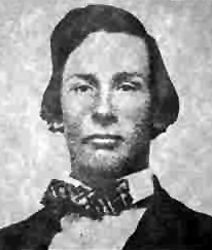
Jack Keetley
Another Eastern Division man was Jack Keetley, who also rode from St. Joseph, Missouri to Seneca, Kansas, alternating at times with Fry and Baughn. Keetley’s greatest performance and one of the most remarkable ever achieved in the service was riding from Rock Creek Station in Nebraska to St. Joseph; then back to his starting point and on to Seneca, and from Seneca once more to Rock Creek Station – 340 miles without rest. He traveled continuously for 31 hours, his entire run being at the rate of eleven miles an hour. During the last five miles of his journey, he fell asleep in the saddle and, in this manner, concluded his long trip.
Don C. Rising, who afterward settled in Northern Kansas, was born in Painted Post, Steuben County, New York, in 1844 and came West when thirteen years of age. He rode in the pony service nearly a year, from November 1860, until the line was abandoned the following October, most of his service being rendered before he was seventeen. Much of his time was spent running eastward out of Fort Kearny until the telegraph had reached that point and made the operation of the Express between the fort and St. Joseph, Missouri no longer necessary. On two occasions, Rising is said to have maintained a continuous speed of 20 miles an hour while carrying important dispatches between Big Sandy and Rock Creek Station in Nebraska.
One rider who was well known as “Little Yank” was a boy scarcely out of his teens and weighing barely one hundred pounds. He rode along the Platte River between Cottonwood Springs, Nebraska, and old Julesburg, Colorado, and frequently made 100 miles on a single trip.
Another man named Hogan, of whom little is known rode northwesterly out of Julesburg, Colorado across the Platte River and to Mud Springs, some 80 miles distant.
The Pony Express building at Rock Creek Station, Nebraska by Kathy Alexander.
Jimmy Clark rode between various stations east of Fort Kearny, usually between Big Sandy, Nebraska, and Hollenberg, Kansas. Sometimes his run took him as far West as Liberty Farm on the Little Blue River.
James W. Brink, or “Dock” Brink as he was known to his associates, was one of the early riders entering the employ of the Pony Express Company in April 1860. While “Dock” made a good record as a courier, his chief fame was gained in a fight at Rock Creek Station, in which Brink and Wild Bill Hickok “cleaned out” the McCanles Gang of outlaws, killing five of their number.
Charles Cliff had an 80-mile pony run when only 17 years of age, but, like Brink, young Cliff gained his greatest reputation as a fighter – in his case fighting Indians. It seems that while Cliff was once freighting with a small train of nine wagons, it was attacked by a party of one hundred Sioux Indians and besieged for three days until a larger train approached and drove the redskins away. During the conflict, Cliff received three bullets in his body and twenty-seven in his clothing, but he soon recovered from his injuries and was afterward nonetheless valuable to the Pony Express service.
Jay G. Kelley, later a citizen of Denver, was a veteran pony man. He entered the company’s employ at the outset and helped Superintendent Roberts layout the route across Nevada. Along the Carson River, tiresome stretches of corduroy road had to be built. Kelley relates that willow trees were cut near the stream in constructing this highway, and the trunks cut into the desired lengths before being laid in place. The men often had to carry these timbers in their arms for 300 yards, while the mosquitoes swarmed so thickly upon their faces and hands as to make their real color and identity hard to determine.
Carson Sink, Nevada
At the Sink of the Carson, in Nevada, a great depression of the river on its course through the desert, Kelley assisted in building a fort for protecting the line against Indians. There were no rocks or timber here, so the structure had to be built of adobe mud. The men tramped it all day with their bare feet to get this mud to proper consistency. According to Kelley’s story, the soil was soaked with alkali, and as a result, their feet were swollen to resemble “hams.”
They next erected a fort at Sand Springs, 30 miles from Carson Lake, and another at Cold Springs, 32 miles east of Sand Springs. At Cold Springs, Kelley was appointed assistant station-keeper under Jim McNaughton. An outbreak of the Paiute Indians was now in progress, and as the little station was in the midst of the disturbed area, there was plenty of excitement.
One night, while Kelley was on guard his attention, was attracted by the uneasiness of the horses. Gazing carefully through the dim light, he saw an Indian peering over the outer wall or stockade. The orders of the post were to shoot every Indian that came within range, so Kelley blazed away but missed his man. In the morning, many tracks were found about the place. This wild shot had probably frightened the prowlers away, saving the station from attack and certain destruction.
During this same morning, a Mexican pony rider came in, mortally wounded, having been shot by the Indians from ambush while passing through a dense thicket in the vicinity known as Quaking Asp Bottom. Although given tender care, the poor fellow died within a few hours after his arrival. The mail was waiting, and it must go. Kelley, who was the lightest man in the place – he weighed but one hundred pounds – was now ordered by the boss to take the dead man’s place and go on with the dispatches. This he did, finishing the run without further incident. On his return trip, he had to pass once more through the aspen thicket where his predecessor had received his death wound. This was one of the most dangerous points on the entire trail, for the road zigzagged through a jungle, following a passageway that was only large enough to admit a horse and rider; for two miles, a man could not see more than thirty or forty feet ahead. Kelley was expecting trouble and went through like a whirlwind, at the same time holding a repeating rifle in readiness should trouble occur. On having cleared the thicket, he drew rein on the top of a hill and, looking back over his course, saw the bushes moving suspiciously. Knowing there was no livestock in that locality and that wild game rarely abounded there, he sent several shots in the direction of the moving underbrush. The motion soon ceased, and he galloped onward, unharmed.
A few days later, two United States soldiers were ambushed and murdered in the same thicket while traveling to join their command.
This was about the time when Major Ormsby’s command was killed in the First Battle of Pyramid Lake, and Indians everywhere in Nevada were unusually aggressive and dangerous. There were seldom more than three or four men in the little station, and it is remarkable that Kelley and his companions were not all killed.
One of Kelley’s worst rides, in addition to the episode just related, was the stretch between Cold Springs and Sand Springs for 37 miles without a drop of water along the way.
Once, while dashing past a wagon train of immigrants, a whole barrage of bullets was fired at Kelley, who narrowly escaped with his life. Of course, he could not stop the mail to see why he had been shot at, but on his return trip, he met the same crowd and told them what he thought of their lawless and irresponsible conduct in unprintable language. The only satisfaction he could get from them in reply was the repeated assertion, “We thought you was an Indian!” Nor was Kelley the only pony rider who took narrow chances from the guns of excited immigrants. Traveling rapidly and unencumbered, the rider, sunburned and blackened by exposure, must have borne on first glance no little resemblance to an Indian; and especially would the mistake be natural to excited wagon-men who were always in fear of dashing attacks from mounted Indians – attacks in which a single rider would often be deployed to ride past the white men at utmost speed to draw their fire. Then when their guns were empty, a hidden band of Indians would make a furious onslaught. It was the established rule of the West in those days, in case of suspected danger, to shoot first and make explanations afterward; to do to the other fellow as he would do to you, and do it first!
Added to the perils of the wilderness deserts, blizzards, and wild Indians – the pony riders, then, had at times to beware of their white friends under such circumstances as have been narrated. And, that added to the tragic romance of their daily lives. Yet, they courted danger and were seldom disappointed, for danger was always near them.
Robert Haslam, aka Pony Bob, 1908
No detailed account of the Pony Express would be complete without mentioning the adventures of Robert Haslam, in those days called “Pony Bob,” and William F. Cody, who is known to fame and posterity as “Buffalo Bill.”
Haslam’s banner performance came about matter-of-factly, as is generally the case with deeds of heroism. On a certain trip during the Paiute raids mentioned, he stopped at Reed’s Station on the Carson River in Nevada and found no change of horses since the white men of the vicinity had appropriated all the animals for a campaign against the Indians. Haslam, therefore, fed the horse he was riding, and after a short rest, started for Bucklands, the next station which was 15 miles down the river. He had already ridden 75 miles and was due to lay off at the latter place. But on arriving, his successor, a man named Johnson Richardson, was unable or indisposed to go on with the mail. It happened that Division Superintendent W. C. Marley was at Bucklands when Haslam arrived, and, since Richardson would not go on duty, Marley offered “Pony Bob” fifty dollars bonus if he would take up the route.
Haslam promptly accepted the proposal, and within ten minutes was off, armed with a revolver and carbine, on his new journey. He at first had a lonesome ride of 35 miles to the Sink of the Carson. Reaching the place without mishap, he changed mounts and hurried on for 37 miles over the alkali wastes and through the sand until he came to Cold Springs. Here he again changed horses and once more dashed on, this time for 30 miles without stopping, till Smith’s Creek was reached where he was relieved by Jay G. Kelley. “Bob” had thus ridden one hundred and 85 miles without stopping except to change mounts. At Smith’s Creek, he slept nine hours and then started back with the return mail. On reaching Cold Springs once more, he found himself in the midst of tragedy. The Indians had been there. The horses had been stolen. All was in ruins. Nearby lay the corpse of the faithful station-keeper. Small cheer for a tired horse and rider! Haslam watered his steed and pounded ahead without rest or refreshment. Before he had covered half the distance to the next station, darkness was falling. The journey was enshrouded with danger.
On every side were vast clumps of sage-brush, which would offer excellent chances for Indians to lie in ambush. The howling of wolves added to the dolefulness of the trip. And haunting him continuously was the thought of the ruined little station and the stiffened corpse behind him. But pony riders were men of courage and nerve, and Bob was no exception. He arrived at Sand Springs safely, but there was no rest or delay here. After reporting the outrage he had just seen, he advised the station man of his danger and, after changing horses, induced the latter to accompany him on to the Sink of the Carson, which move doubtless saved the latter’s life. Reaching Carson, they found a badly frightened lot of men who had been attacked by the Indians only a few hours previously. A party of fifteen with plenty of arms and ammunition had gathered in the adobe station, which was large enough also to accommodate as many horses. Nearby was a cool spring of water, and, thus fortified, they were to remain, in a state of siege, if necessary, until the marauders withdrew from that vicinity. Of course, they implored Haslam to remain with them and not risk his life venturing away with the mail. But the mail must go, and the schedule, hard as it was, must be maintained. “Bob” had no conception of fear, and so he galloped away after an hour’s rest. And back into Bucklands, he came unharmed, after having suffered only three and a half hours of delay.
Superintendent Marley, who was still present when the daring rider returned, at once raised his bonus from fifty to one hundred dollars.
Nor was this all of Haslam’s outstanding achievements. The west-bound mail would soon arrive, and there was nobody to take his regular run. So after resting an hour and a half, he resumed the saddle and hurried back along his old trail, over the Sierras to Friday’s Station. Then “Bob” rested after having ridden 380 miles with scarcely eleven hours of lay-off and within a very few hours of regular schedule time all the way. In speaking of this performance afterward, Haslam modestly admitted that he was “rather tired” but that “the excitement of the trip had braced him up to stand the journey.”
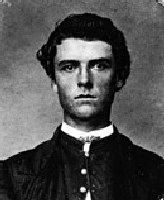
William F. Cody at 19
The most widely known of all the pony riders is William F. Cody – usually called “Bill,” who in early life resided in Kansas and was raised amid the exciting scenes of frontier life. Cody had a hazardous route between Red Buttes and Three Crossings. The latter place was on the Sweetwater River and derived its name from the stream that followed the bed of a rocky canyon that had to be crossed three times within a space of sixty yards. The water coming down from the mountains was always icy cold, and the current swift, deep, and treacherous. The whole bottom of the canyon was often submerged, and in attempting to follow its course along the channel of the stream, both horse and rider were liable to plunge at any time into some abysmal whirlpool. Besides the excitement which the Three Crossings and an Indian country furnished, Cody’s trail ran through a region that desperadoes often frequented.
Furthermore, he had to ford the North Platte River when the stream was half a mile wide and in places 12 feet deep. Though the current was at times slow, dangers from quicksand were always to be feared on these prairie rivers. Cody, then but a youth, had to surmount these obstacles and cover his trip at an average of 15 miles an hour.
Cody entered the Pony Express service just after the line had been organized. At Julesburg, Colorado, he met George Chrisman, a head wagon-master for Russell, Majors, and Waddell freighting department. Chrisman was acting as an agent for the express line, and, out of deference to the youth, he hired him temporarily to ride the division then held by a pony man named Trotter. It was a short route, one of the shortest on the system, aggregating only 45 miles, and three horses’ relays each way. Cody, who had been accustomed to the saddle all his young life, had no trouble following the schedule. Still, after keeping the run several weeks, the lad was relieved by the regular incumbent and then went east, to Leavenworth, where he fell in with another old friend, Lewis Simpson, then acting as wagon boss and fitting up at Atchison, Kansas a wagon train of supplies for the old stage line at Fort Laramie, Wyoming and points beyond. Acting through Simpson, Cody obtained a letter of recommendation from Mr. Russell, the head of the firm, addressed to Jack Slade, Superintendent of the division between Julesburg and Rocky Ridge, with headquarters at Horseshoe Station, 36 miles west of Fort Laramie, in what is now Wyoming. Armed with this letter, young Cody accompanied Simpson’s wagon train to Laramie and soon found Superintendent Slade. The superintendent, observing the lad’s tender years and frail stature, was skeptical of his ability to serve as a pony rider; but on learning that Cody was the boy who had already given satisfactory service as a substitute some months before, at once engaged him and assigned him to the dangerous run of 76 miles between Red Buttes and Three Crossings.
Pony Express Rider, about 1861.
For some weeks, all went well. Then, one day when he reached his terminal at Three Crossings, Cody found that his successor, who was to have taken the mail out, had been killed the night before. As there was no extra rider available, it fell to young Cody to fill the dead courier’s place until a successor could be procured. The lad was undaunted and anxious for the added responsibility. Within a moment, he was off on a fresh horse for Rocky Ridge, 85 miles away. Notwithstanding the dangers and great fatigue of the trip, Cody rode safely from Three Crossings to his terminal and returned with the eastbound mail, going back over his own division and into Red Buttes without delay or mishap – an aggregate run of three hundred and 22 miles. This was probably the longest continuous performance without a formal rest period in the history of this or any other courier service.
Not long afterward, Cody was chased by a band of Sioux Indians while making one of his regular trips. The Indians were armed with revolvers and made it lively for the young messenger for a few minutes. But the superior speed and endurance of his steed soon told; lying flat on the animal’s neck, he quickly distanced his assailants and thundered into Sweetwater, the next station, ahead of schedule. Here he found – as so often happened in the history of the express service – that the place had been raided, the keeper slain, and the horses were driven off. There was nothing to do but drive his tired pony 12 miles further to Ploutz Station, where he got a fresh horse, briefly reported what he had observed, and completed his run without mishap.
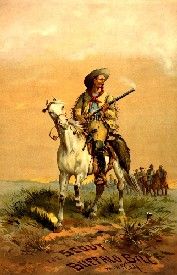
Buffalo Bill Cody, 1872
On another occasion, it became mysteriously rumored that a particular Pony Express pouch would carry a large sum of currency. Knowing that there was a significant likelihood of some bandits or “road agents,” as they were commonly called, getting wind of the consignment and attempting a holdup, Cody hit upon a little emergency ruse. He provided himself with an extra mochila which he stuffed with waste papers and placed over the saddle in the normal position. The pouch containing the currency was hidden under a special saddle blanket. With his customary revolver loaded and ready, Cody then started. His suspicions were soon confirmed, for on reaching a particularly secluded spot, two highwaymen stepped from concealment and, with leveled rifles, compelled the boy to stop, at the same time demanding the letter pouch. Holding up his hands as ordered, Cody began to remonstrate with the thugs for robbing the express, at the same time declaring to them that they would hang for their meanness if they carried out their plans. In reply, they told Cody that they would take their own chances. They knew what he carried, and they wanted it. They had no particular desire to harm him, but unless he handed over the pouch without delay, they would shoot him full of holes and take it anyhow. Knowing that to resist meant certain death, Cody began slowly to unfasten the dummy pouch, still protesting with much indignation. Finally, after having loosed it, he raised the pouch and hurled it at the head of the nearest outlaw, who dodged, half amused at the young fellow’s spirit. Both men were thus taken slightly off their guard, and that instant, the rider acted like a flash. Whipping out his revolver, he disabled the farther villain; and before the other, who had stooped to recover the supposed mail sack, could straighten up or use a weapon, Cody dug the spurs into his horse, knocked him down, rode over him, and was gone. Before the half-stunned robber could recover himself to shoot, horse and rider were out of range and running like mad for the next station, where they arrived ahead of schedule.
The following is a partial list, so far as is known, of the men who rode the Pony Express and contributed to the lasting fame of the enterprise:
Jim “Boston” Baughn
Melville Baughn
Jim Beatley
William Boulton
James W. “Doc” Brink
John Burnett
Jimmy Bucklin
William Carr
William Carrigan
Bill Cates
Jimmy Clark
Charles Cliff
William F. Cody
Howard “Major” Egan
Jack K. “JK” Ellis
H. J. FaustJohn Fisher
William “Billy” Fisher
Johnny Fry
Jim Gentry
Jim Gilson
“Irish Tom” Grady
Sam Hamilton
John Hancock
Robert “Pony Bob” Haslam
Martin Hogan
Let Huntington
William James
Will D. Jenkins
Jay G. Kelley
Jack Keetley
Bob Martin
J. G. McCall
James McDonald
Jim McNaughton
James “Jim” Moore
Theodore “Little Yank” Rand
Josh Perkins Johnson Richardson
Bart Riles
Don C. Rising
Harry Roff
George Spurr
George Thacher
Charles P. “Cyclone Charlie” Thompson
George Towne
Henry Wallace
Dan Westcott
Jose Zowgaltz
John Fisher, John Hancock, and Billy Fisher, Pony Express Riders
Many of these men were rough and unlettered. Many died deaths of violence. The bones of many lie in unknown graves. Some doubtless lie unburied somewhere in the great West, in the winning of which their lives were lost. Yet, be it always remembered that they played an important part in the history of the American nation. They were bold-hearted citizen knights to whom is due to the honors of uncrowned kings.
By Glenn D. Bradley, 1913. Compiled and edited by Kathy Alexander/Legends of America, updated March 2022.
Also See:
Johnny Fry – First Rider of the Pony Express
Pony Bob Haslam & the Longest Ride
Pony Express – Fasted Mail Across the West
Pony Express Stations Across the American West
Tales & Trails of the American West
About the Article: This article was excerpted from Glenn D. Bradley’s book, The Story of the Pony Express, published by the A. C. McClurg & Co., Chicago, Illinois in 1913. However, the story as it appears here is far from verbatim, as it has been heavily edited for clarification, spelling, and ease of the modern reader.

